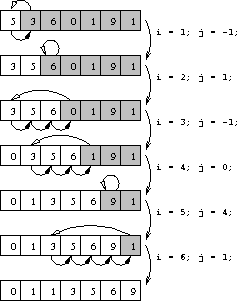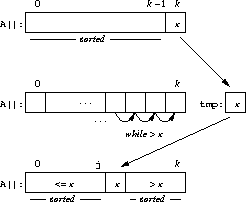

Prev: Programming Using Induction
Next: Invariants and Recursive Algorithms
- by Brad Bart, Simon Fraser University
- Programming Using Induction
- Loop Invariants
- Invariants and Recursive Algorithms
Loop Invariants
SumOdd(n)
look very much like the
inductive step. This is not a coincidence. Loop invariants are
usually statements about an algorithm that you can prove by
induction. The most useful invariants will be about either:
- the progress of the algorithm; or
- the running time of the algorithm.
A[0..n-1]:
void isort(int *A, int n) {
for (int i = 1; i < n; i++) {
// insert A[i] into A[0..i-1]
int temp = A[i];
int j = i-1;
// shift all A[] > temp
while (j >= 0 && A[j] > temp) {
A[j+1] = A[j];
j--;
}
A[j+1] = temp;
}
}
SumOdd:
int SumOdd(int n) {
total = 1;
for (int i = 2; i <= n; ++i) {
assert(total == (i-1)*(i-1));
total += (2*i - 1);
assert(total == i*i);
}
}

A[i] is
located by finding all those elements to its left which are larger.
Those elements are shifted up by one position to make
space for the insertion of A[i]. A demonstration on
an array of 7 elements is shown to the
left.
Insertion Sort is an incremental sort.
Each loop begins with a sorted A[0..i-1], and the
element A[i] is joined to it such that the
result is a sorted A[0..i]. In other words:
At the beginning of each loop,This is a loop invariant about the progress of the algorithm.A[0..i-1]is a sorted permutation of the firstielements ofA[], and at the end of each loopA[0..i]is a sorted permutation of the firsti+1elements ofA[].
Once you have declared a loop invariant, your next goal is to prove it by induction. Why? Because the byproduct of your proof will be a proof of correctness of the algorithm.
Remember that the goal of a sorting algorithm is to permute
the elements of A[0..n-1] such that they are in
sorted order. At the end of the final loop, i.e., when
i = n-1, the result will be a sorted permutation
of the first n elements of A[].

i):
-
Inductive Step: Assume all loop invariants hold for
all loop indices
i< k, and conclude that they hold for the loop indexi= k.Certainly,
A[0..k-1]is sorted at the beginning of the loopi= k, because it was sorted at the end of loopi= k − 1.To show that
A[0..k]is sorted at the end of the loopi= k, we follow the execution of the loop body. Let x =A[k]. Informally speaking, thewhileloop shifts elements to a higher index, as long as they are greater than x. Since that portion of the list was sorted, it remains sorted, because the order is maintained on an incremental shift.1 When the loop terminates, the value ofjis such thatA[0..j]≤ x <A[j+2..k]. The final step of assigningA[j+1]← x generates a sortedA[0..k]. □
And now to declare an invariant about the running time. Because the inner while loop runs an indefinite number of times, it will be impossible to construct an invariant that states the running time as an equation. Instead, the loop invariant will be a description of the worst case, i.e., the largest number of steps, using an inequality.
void isort(int *A, int n) {
for (int i = 1; i < n; i++) {
// insert A[i] into A[0..i-1]
int temp = A[i];
int j = i-1;
// shift all A[] > temp
while (j >= 0 && A[j] > temp) {
A[j+1] = A[j];
j--;
}
A[j+1] = temp;
}
}
On each iteration of the while loop, there are
2 comparisons for testing the entry condition and
2 assignment operations for shifting A[j] and
updating j. In the worst case, this will run
until j = −1, costing one more comparison.
Therefore, the total running time of the inner loop must be
≤ 4i + 1
operations.
Each iteration of the outer for loop performs
3 assignment operations plus at most
4i + 1
operations for the inner
while, so the running time of the
ith
outer loop must be
≤ 4i + 4
operations.
Therefore, the loop invariant for the running time
of Insertion Sort is:
The total running time, T(k), of the loops i = 1, . . ., k, satisfies:
 .
.
-
Since T(k + 1), the total time to run loops i = 1, . . ., k + 1, equals the sum of T(k), the total time to run loops i = 1, . . ., k, plus the time to run loop i = k + 1, we have

![$\displaystyle \leq T(k) + [4(k+1)+4)]$](img65.png)
![$\displaystyle \leq \displaystyle{\sum_{i=1}^{k} (4i+4)} + [4(k+1)+4]$](img66.png)
 Inductive Hypothesis
Inductive Hypothesis

 ,
,
and this proves that Insertion Sort runs in quadratic time in the worst case.

 Next: Invariants and Recursive Algorithms
Next: Invariants and Recursive Algorithms